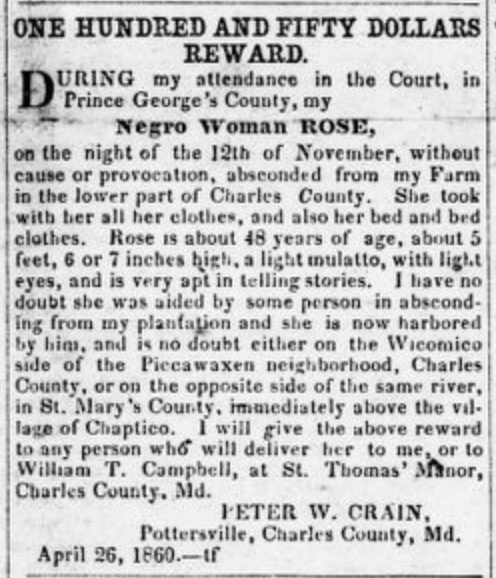See “the many Patrick Stewarts” for the introduction to why this post was written.
Patrick Stewart of Hillsdale was originally considered as Patrick Stewart of Queen Anne District due to his age and geographic location in the 1870 Census. The 1870 Census gave his age as 50 [1850] which makes him the same age as Patrick Stewart of Queen Anne District. Additionally, he was residing in Hillsdale, a community of freed Black people that had escaped to the District like Patrick Stewart of Queen Anne District had.
However, a review of further records related to him suggests he was not from Queen Anne District, but rather southern Prince George’s County and Charles County, Maryland.
After Emancipation
In the 1870 Census, Patrick Stewart is living in Hillsdale, a community of freed Black people, originally known as Barry Farm and run by the Freedmen’s Bureau. It was called Barry Farm as it had been built on a 375 acre of land that had been owned by the Barry family.

The 1878 Hopkins Map shows it as Potomac City. An act passed in 1873 changing the name of “Barry Farm, or Potomac” to Hillsdale in 1873. Charles R Douglass, a relative of Frederick Douglass, was a political leader within the Hillsdale community. Douglass was enumerated at dwelling number (DN) 602; Patrick Stewart at DN 599.

In 1870, Patrick Stewart was not listed in the Washington, DC City Directories. He appeared in the City Directories in 1875 as living on Howard Avenue, in Hillsdale. Howard Avenue is situated in the northwest portion of HIllsdale, running parallel to Stickfoot Branch. An 1867 Tax List ran in the National Republican and cited “Whole Tax on lot 38 and improvements in section 9, in Barry Farm subdivision, assessed to Patrick Stewart, $5.25”.

This lot sat on the end of Howard Ave along the river and was larger than the other 1 acre lots. The acreage most likely allowed Patrick to ply his trade as a carpenter.
“In order to purchase property, entire families worked in the city all day and walked at night to Barry’s Farm to develop their land and construct their homes by lantern and candlelight. As one man described it, ‘the hills and valleys were dotted with lights. The sound of hoe, pick, rake, shovel, saw and hammer rang through the late hours of the night.’”
The Anacostia Story (1977) | Louise Daniel Hutchinson
In the 1870 Census, Patrick Stewart is living with his wife, Caroline, and his children: Julia, Georgie and Joseph. They are also living with Henry Stewart, age 93. Presumably, Henry is Patrick’s father.
Two of the children, Julia and Georgie, were born prior to emancipation. Joseph was born after emancipation and when the family was living in the District.
Before Emancipation
George Morton, a landholder and enslaver from the Eighth District, submitted a compensation list that included Caroline Stewart, Julia and Georgiana, as well as an older and younger daughter, who do not appear in the 1870 census with Patrick and Caroline.

The Eighth District was in the southernmost part of Prince George’s County, along the boundary with Charles County. George Morton is shown on the Martenet Map as holding land east of Woodville.

Maria Stewart Briscoe
Maria Briscoe and her two children Henrietta and Ben Briscoe are enumerated immediately following Caroline Stewart and her named children in the 1867 compensation lists for George Morton.

Like her parents and siblings, Maria and her partner, Richard Briscoe, left the Aquasco area and purchased a lot in Hillsdale. Richard Briscoe was assessed for his lot: “Whole Tax on lot 35 and improvements in section 8, Barry Farm Subdivision, assessed to Richard Briscoe, $4.13” His lot was near but not adjacent to the Patrick Stewart lot.

Both Richard Briscoe and Patrick Stewart were carpenters; many skilled workers found lots in Hillsdale.
Maria’s death record records her parents as Caroline Wood and Patrick Stewart and her husband as Richard Briscoe. Her transcribed death record inaccurately records her age as 61. Based on the emancipation records, she was in her eighties, which is consistent with her 1920 census record.
Mattawoman Baptismal Records
In a no longer extant parish, “Upper and Lower Zachiah and Mattawoman”, there were three chapels:
- A private chapel on the estate of William Boaman (near Bryantown) in Lower Zachiah
- A chapel on Thomas Reeve’s land on the Upper Zachiah (later St. Peter’s parish in Waldorf)
- A chapel “located south of the later parish of St. Mary’s in Piscataway”

There are three baptismal records in the Maryland, U.S., Births and Christenings Index, 1662-1911 Database associated with “Roman Catholic, Mattawoman, Charles, Maryland”.
- 25 Apr 1857, the baptism of Julia Stewart, daughter of Patrick Stewart and Caroline
- 8 May 1859, the baptism of Georgiana Stewart, daughter of Patrick and Carolina
- 27 Jun 1859, the baptism of Henrietta Briscoe, daughter of Richard and Marg Briscoe
Disambiguation
Despite Patrick Stewart having a similar birth year, and reasonable 1870 residence, he is not Patrick Stewart of Queen Anne District. He was a carpenter from southern Prince George’s County and northern Charles County.


